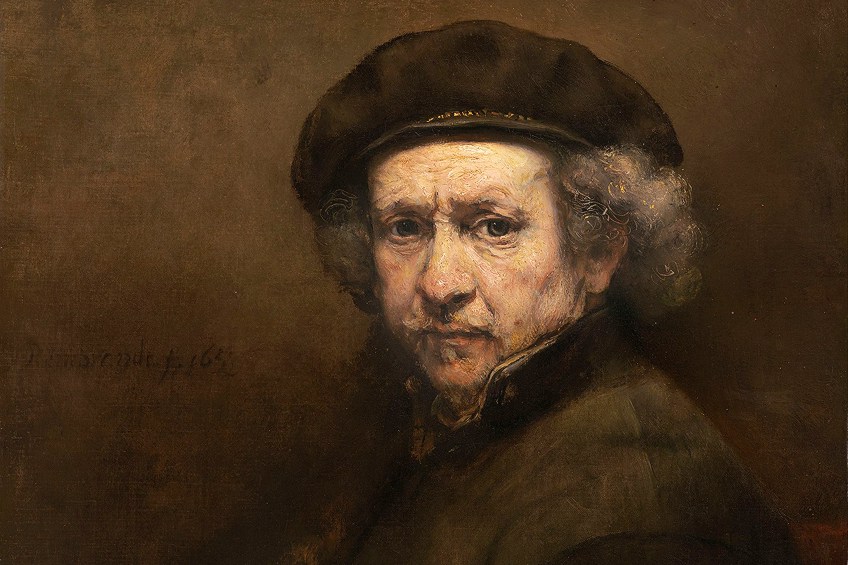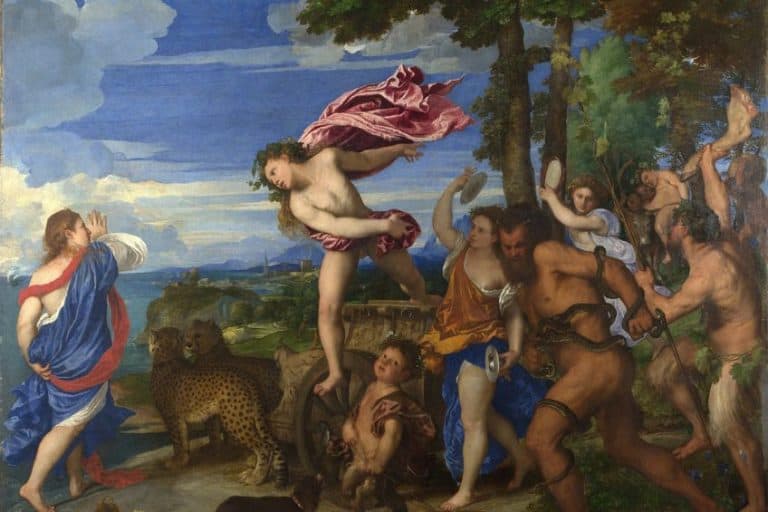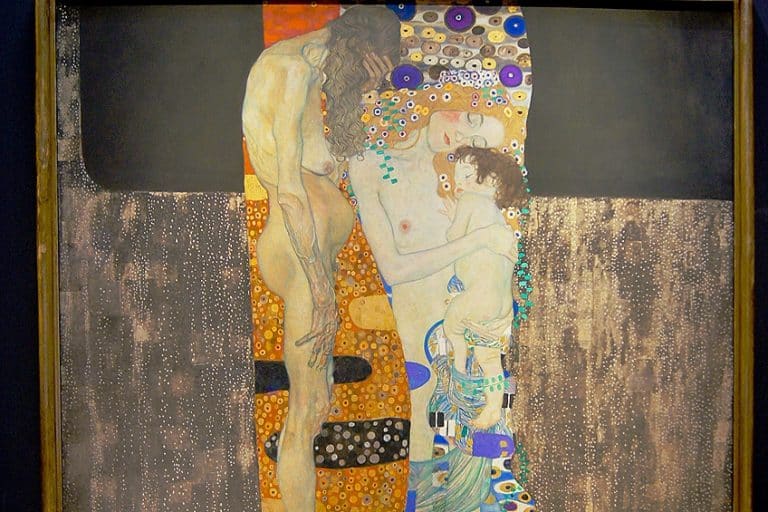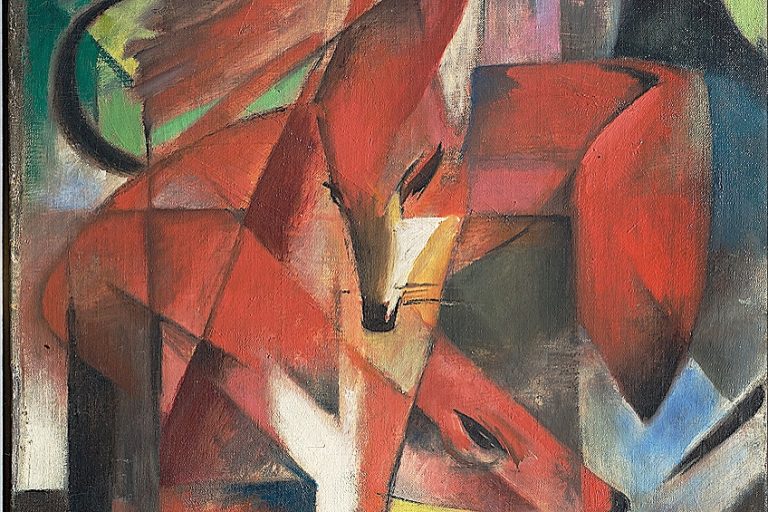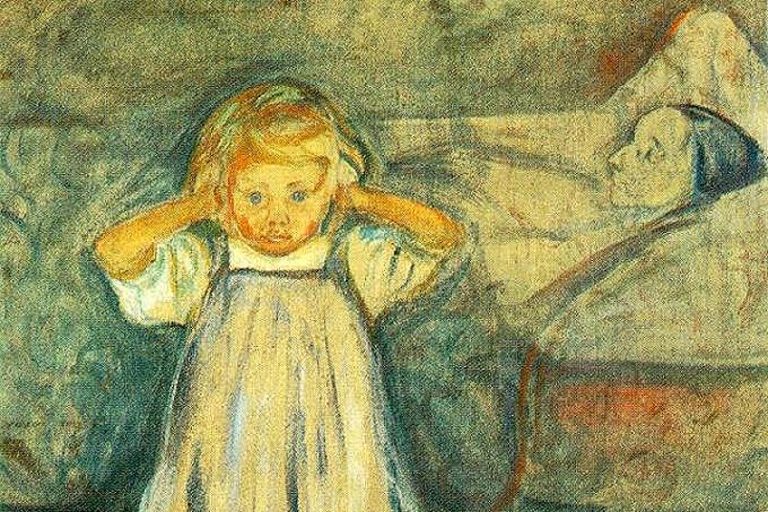Rembrandt Self-Portrait – Van Rijn’s Visual Autobiographies
Rembrandt’s self-portraits were a significant component of his output. These paintings by Rembrandt numbered around one hundred self-portraits. But why did Rembrandt make so many self-portraits, and which are the most noted works?
Rembrandt’s Self-Portraits
Rembrandt’s self-portraits consist of more than 40 paintings, 31 etchings, and around seven sketches. This was a huge amount for any artist at the time, and it accounted for around 10% of his work in both paintings and engravings. For instance, Rubens, despite his prolific output, only painted seven self-portraits. But who was Rembrandt? Let us start by taking a brief look at the artist.
Who Was Rembrandt van Rijn?
| Nationality | Dutch |
| Date of Birth | 15 July 1606 |
| Date of Death | 4 October 1669 |
| Place of Birth | Leiden, Dutch Republic |
Rembrandt’s life and art were fueled by a rigorous psychological study of people, things, and their environment, as well as a genuine Christian devotion. He was an incredible artist from an early age, becoming a master of all sorts of portraits, historic, religious, and mythical settings, as well as basic, appealing yet dramatic vistas. He developed his message using a variety of materials and approaches with extraordinary sensitivity and immediacy.
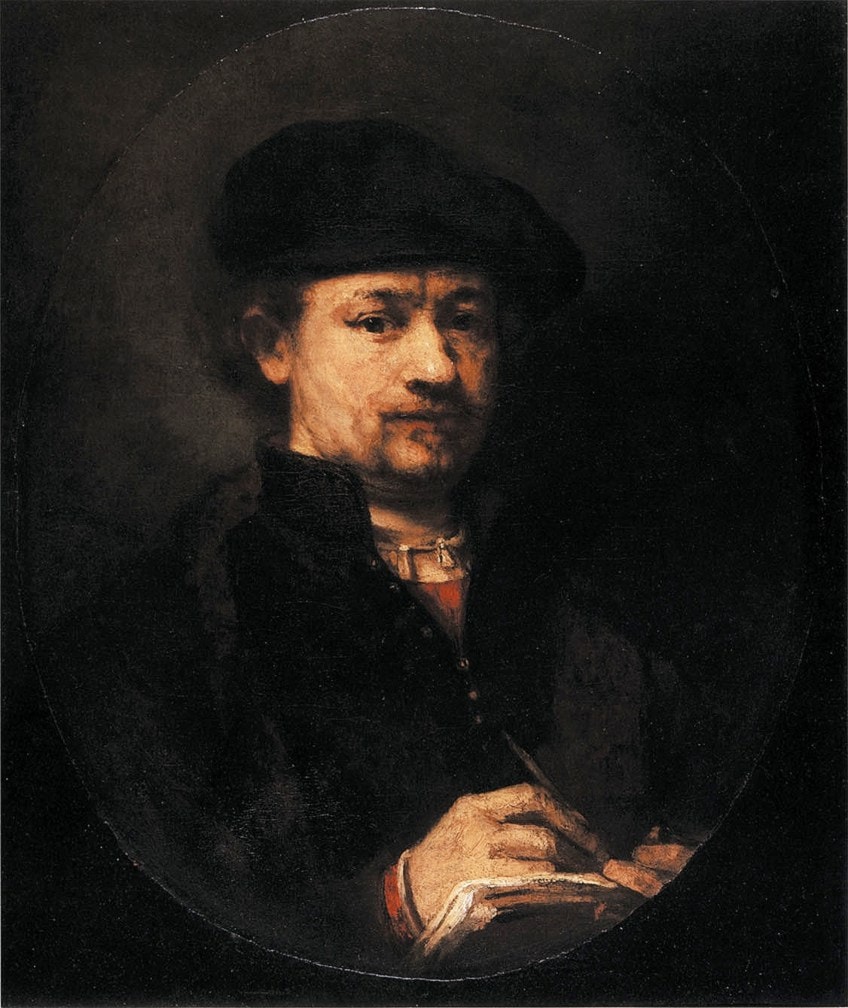
His methods to structure, color, and shadows were always evolving, resulting in the most intensely affecting but most natural aspects of human life. His amazing control of lighting and texture to express emotional range runs a common thread throughout all of his masterpieces, solidifying his place as one of art’s finest and most inventive masters.
These characteristics may be seen in his enormous, ambitious early historical paintings as well as his more personal and bright later manner.
Rembrandt was famous for his exceptional capacity to show not just incredibly lifelike, real-life human beings, but also profound human sentiments, faults, and morals. He thought that human emotions were more essential than any other component of life, and he intended to express his subjects’ sentiments and sensations even while painting them from the perspective of history, faith, or culture.
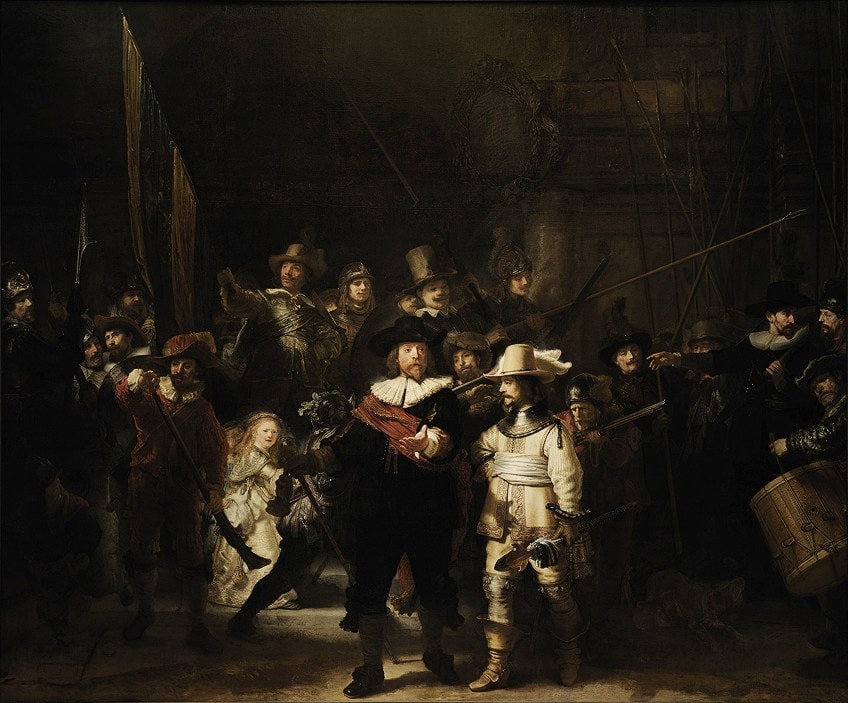
Rembrandt’s development of the etching method from a comparatively recent reproduction technology into a real art form was one of his most significant accomplishments. His status as the finest etcher in the format’s history endures to this day. Although few of his artworks were exported from the Dutch Republic during his tenure, his prints were extensively distributed across Europe. Rembrandt’s vast self-portraits are significant because they contribute to a one-of-a-kind visual history of the painter. He studied himself devoid of vanity and with a sensitive candor, whether he was portraying himself in dress or as an ordinary person.
Portraiture became fashionable during the Dutch Golden Age.
Members of the new trader class relished commissioning inventive likenesses of themselves to showcase in their residences, and businesses and other skilled institutions would also obtain group portrayals as a result of the new shipping routes bringing consciousness of exotic societies and foreign entities. Rembrandt was a brilliant portrait painter of his day, famed for his ability to capture his subjects’ particular characteristics and temperamental quirks.

Despite the fact that illustrated scenarios from the Scripture and large-scale historical works were out of favor, Rembrandt remained committed to the form, driven by a strong religious commitment and compassion for the human situation. Because of his sympathetic interpretation of these age-old traditions, he has been dubbed one of civilization’s great prophets. With his increasing manipulation of paint, Rembrandt would transcend the ingenuity of Titian and Velazquez, rendering it as much a topic in the arrangement of the work as his subjects.
Brushstroke differences between free and harsh, as well as texture modification by scraping or with a palette knife, would all significantly contribute to a completely new hallmark style that would impact future groups.
Self-portrait Paintings by Rembrandt
The self-portraits serve as a pictorial journal of the artist’s life over the course of 40 years. They were created at a fairly consistent rate throughout his career, although there is a progressive transition from etchings, which were more popular until the 1630s, to canvases, which became more common after that. There is, nevertheless, a hiatus in works between 1645 and 1652.
The final three etchings were made between 1648 and 1658, and he was still producing portraits in 1669, the year he passed away at the age of 63. Rembrandt’s self-portraits were formerly counted at around 90 pieces, but it is now established that he had his apprentices replicate his own self-portraits as a component of their training. Modern studies, particularly the Rembrandt Research Project, have decreased the signature count to more than 40 paintings, a few sketches, and thirty-one etchings, which contain many of the group’s most stunning works.
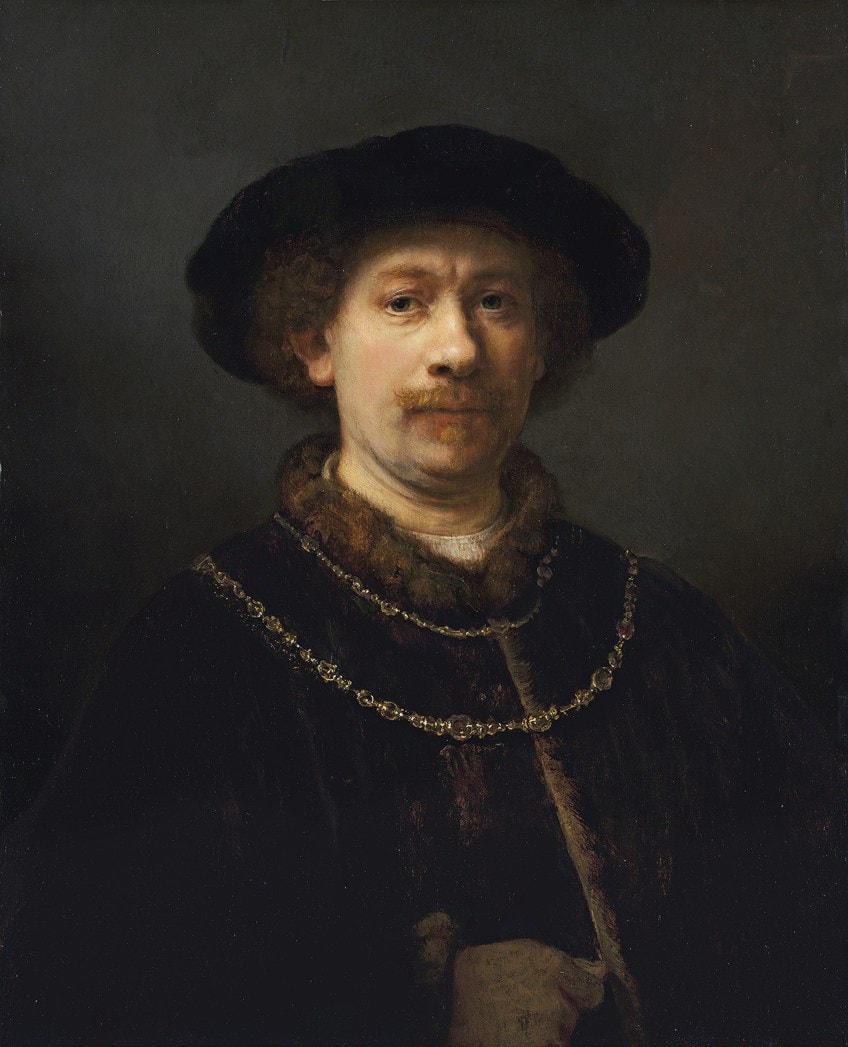
The etchings are generally informal, frequently amusing pieces, studies of exaggerated facial gestures, or portraiture in what amounted to fancy dress; in some of them, the outfits are from a century or more ago. In others, he is making fun of himself. His oil paintings follow him from an insecure young man to the stylish and immensely successful portrait-painter of the 1630s to the anguished yet tremendously compelling portraits of his old age. They paint a wonderfully accurate image of the guy, his looks, and his personality, as indicated by his beautifully worn face.
According to Kenneth Clark, Rembrandt is “the only painter, with the potential exception of Van Gogh, who has rendered the self-portrait a primary means of creative self-expression, and he is unquestionably the one who has converted self-portraiture [to be] autobiographical.”
While the conventional interpretation is that these images portray a private and contemplative trip, they were also created to meet a demand for self-portraits by great painters. Collectors appear to have purchased both canvases and etchings, and while some etchings are extremely rare, others were produced in large quantities for the time.
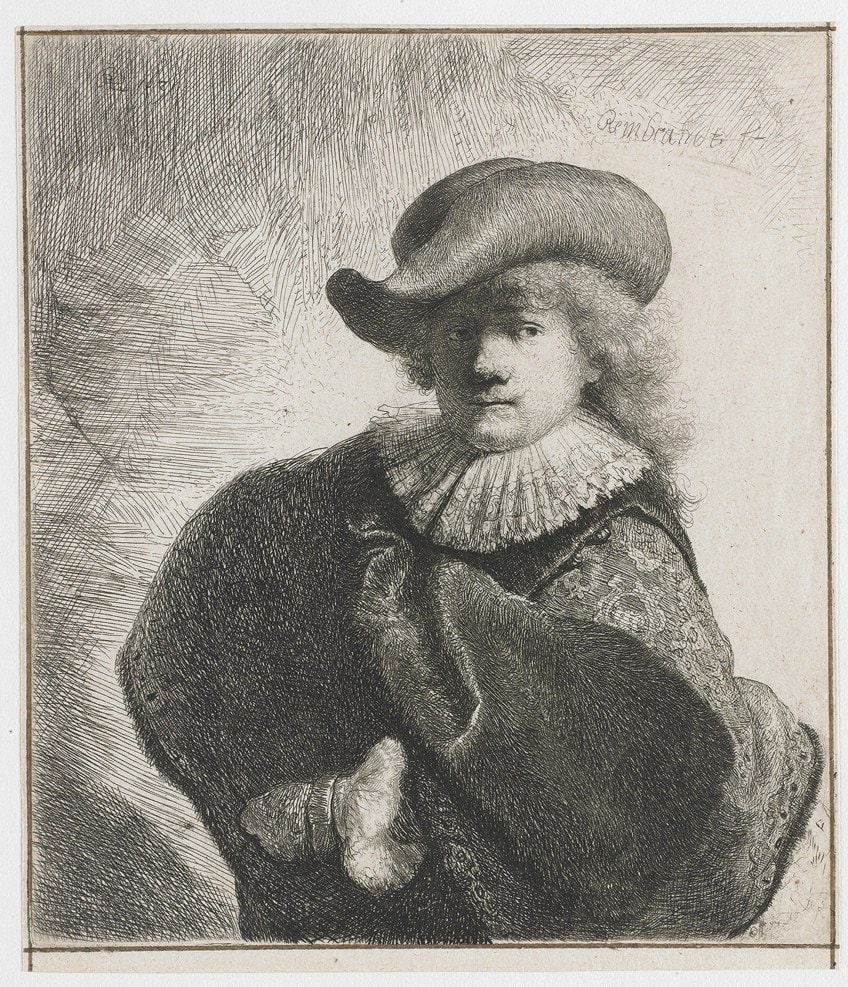
There were no self-portraits in the renowned 1656 catalog, and just a few of the works survived in the estate after his death. Rembrandt’s self-portraits were made by the artist staring in the mirror at himself, and the artworks and sketches thereby reverse his true characteristics. The printing method in the etchings generates an inverted picture, thus the prints portray Rembrandt in the same position as he looked to peers.
This is one of the reasons why the hands are frequently deleted or “just perfunctorily portrayed” in the artworks; if portrayed from the mirror, they would be on the “incorrect” side.
Allusions to huge mirrors appear at different places beginning in the 1650s, and subsequent portraits include some portraying him at a larger length than previously; around 80 cm was the highest height for a piece of mirror glass theoretically conceivable during Rembrandt’s time. One may have been purchased about 1652 and subsequently sold when he went bankrupt in 1656. In 1658, he instructed his son Titus to organize for the arrival of another one, which had broken down on the way to his house.
Self-Portrait (Vienna) (1652)
| Year Completed | 1652 |
| Medium | Oil on Canvas |
| Dimensions | 112 cm x 81 cm |
| Current Location | Kunsthistorisches Museum, Vienna |
Its composition varies from his past self-portraits in that it depicts the painter in a straight frontal stance, with his hands on his hips and an air of self-assurance. It was created the year his financial problems started, and it departs from the lavish regalia he had donned in earlier self-portraits. According to art historians, it is “among the most majestic and melancholy of these later images.”
A brown cloak, most likely informal labor wear, was tied with a sash and worn over a black doublet with an upturned collar among the freely painted apparel. A painting from around 1650 depicts Rembrandt in a similar attitude and dress, with an annotation, albeit not by the creator’s hand, claiming that they were the artist’s workshop clothes.
In the sketch, Rembrandt wears a top hat, however, in the painting, he sports a black beret derived from 16th-century painters’ portraits.
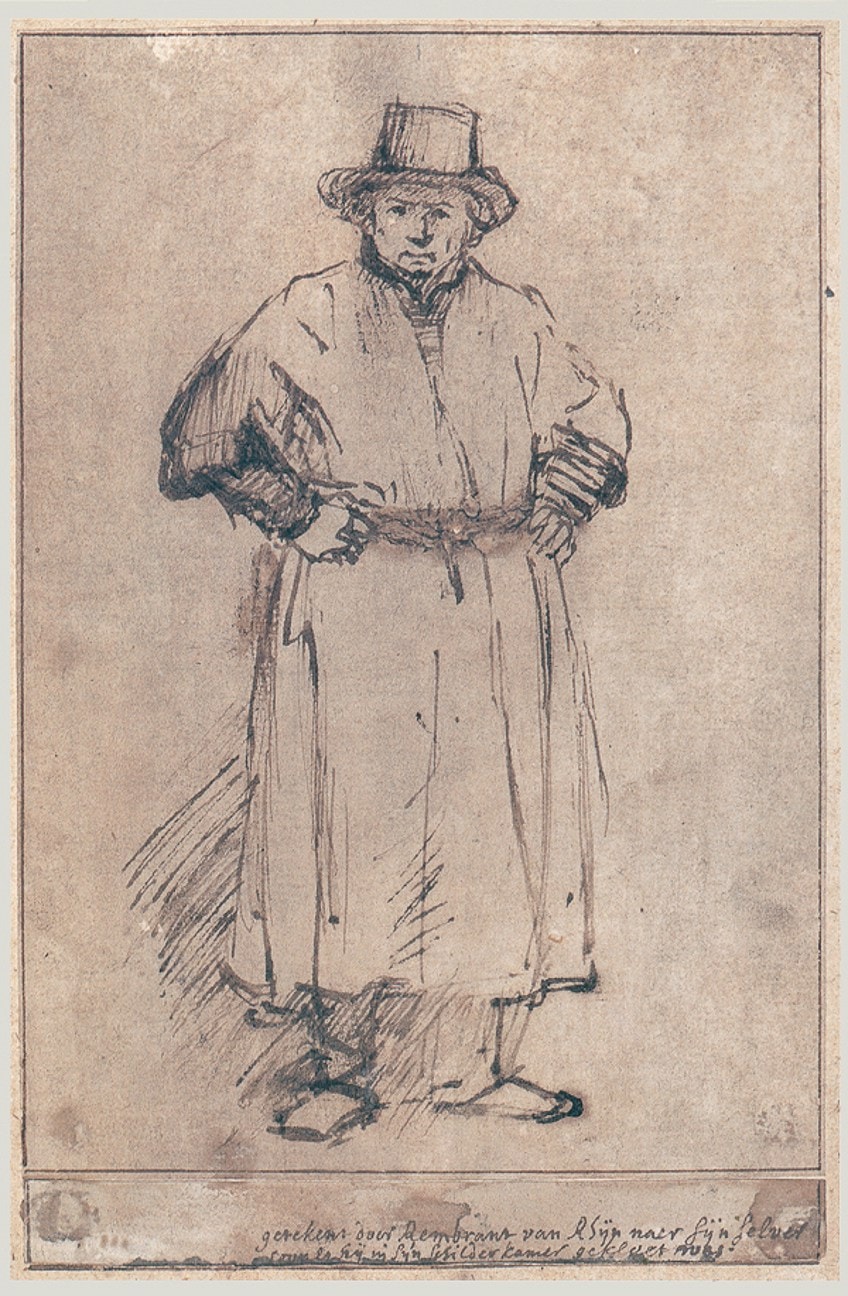
After a seven-year hiatus in which he created no self-portraits, instead focusing on landscapes and personal home subjects, the Vienna Self-Portrait began a prolific period in which Rembrandt completed an average of one self-portrait each year until his passing in 1669. Contrary to common belief, these artworks were created expressly for enthusiasts who collected self-portraits by great painters, according to Ernst van de Wetering.
Another underlayer of paint comes through in some parts of shadowing, notably in the area by the eye sockets and also behind the mustache, as it does in Rembrandt’s other later portraits and self-portraits. Microscopic examination reveals that this is not the colored base layer, which has a comparable gray tone, but rather a distinct underlayer of paint.
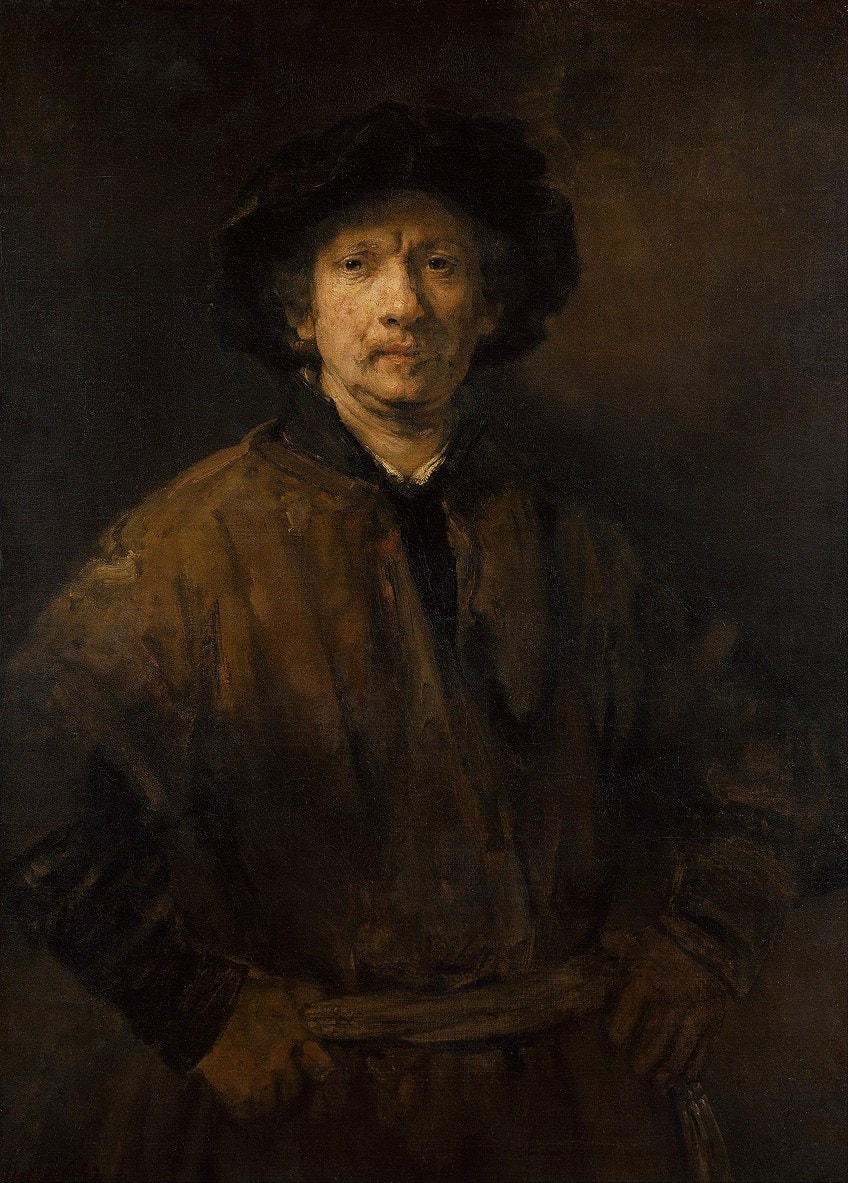
This local imprimatur, which was employed in preparation for certain portions of the painting, was also utilized by Vermeer, and its function is unknown. A striking resemblance has been recognized to a self-portrait from around 1655, which is also housed in the Vienna Kunsthistorisches Museum. The subsequent piece matches the larger painting’s frontal position, lighting, and casual dress, while the artist’s face seems older.
Self-Portrait with Beret and Turned-Up Collar (1659)
| Year Completed | 1659 |
| Medium | Oil On Canvas |
| Dimensions | 84 cm x 66 cm |
| Current Location | National Gallery of Art |
Self-Portrait with Beret and Turned-Up Collar (1659) is an oil on canvas work. It is one of Rembrandt’s nearly 40 self-portraits. It has been described as a delicate and gloomy self-portrait, a work in which “the tensions and pressures of a life consisting of creative achievements and emotional and financial failures” may be observed. It was once acquired by Andrew W. Mellon and has since 1937 been on display at the National Gallery of Art.
Description
Rembrandt is reclining under a boldly painted fur coat, his hands folded in his lap, in this Self-Portrait. The light from the top right highlights the whole face, thinning out the shape of the cheek and enabling the portrayal of imperfections on the cheekbone and ear lobes. The painting is done in a muted palette of brown and gray, supplemented by a red object that may be the backrest of his chair, and another red patch in the bottom left-hand corner of the painting could be a tablecloth.
The creator’s face, which is the most dazzling, is surrounded by a huge beret and a high collar that conceals his cheeks.
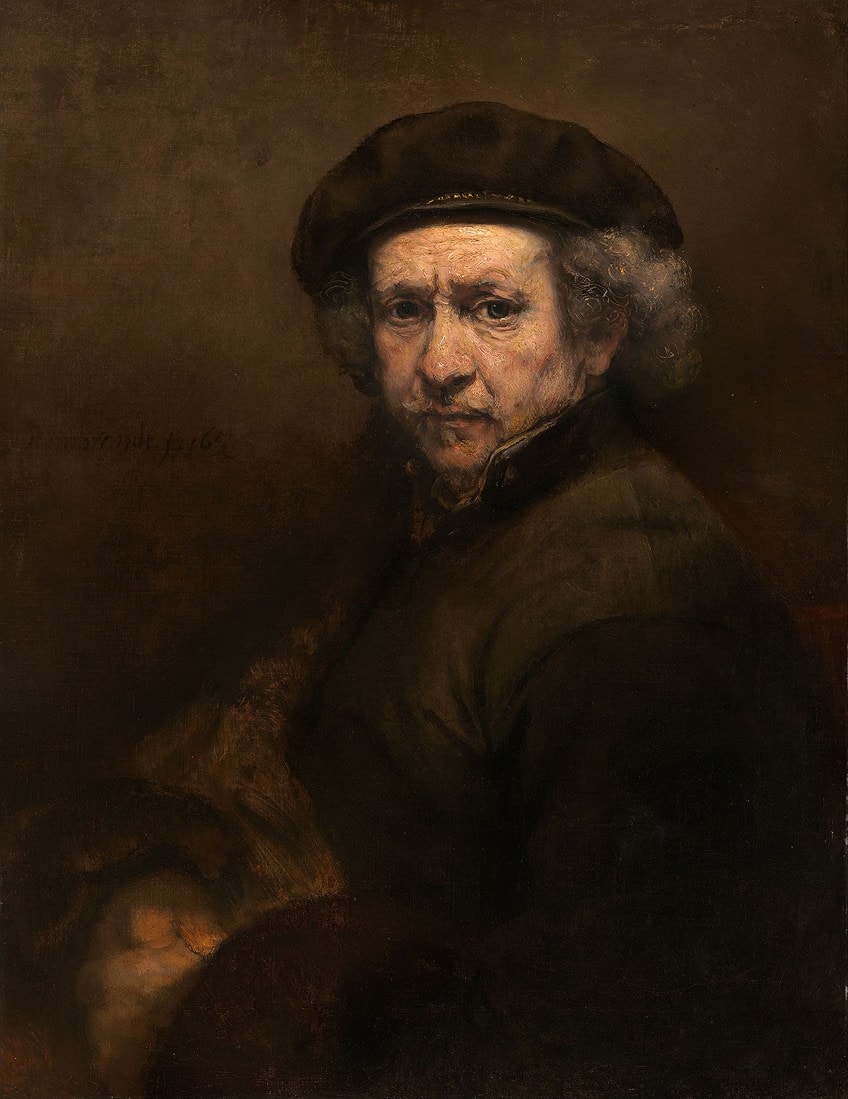
The flesh of the face is molded with dense, tactile pigments and colored in rich, variegated colors, alluding to the artist’s bodily aging as well as the mental ramifications of life experiences. Rembrandt originally portrayed himself donning a light-hued cap before switching to the black beret; because the initial headpiece was of a type that the painter only would include in self-portraits where he is seen at the easel, it is feasible that he aimed for this artwork to directly refer to his craft.
Composition
The posture is evocative of numerous previous Rembrandt pieces, notably an etching titled Self-Portrait Leaning on a Stone Sill (1639). This earlier work has been seen as a reference to Portrait of Baldassare Castiglione by Raphael. The folded hands and black fabric-covered left arm are reminiscent of the Raphael picture. The posture of the body and head, which is rare among Rembrandt’s self-portraits, is also evocative of the Raphael work.
When depicting himself, Rembrandt usually utilized the more comfortable configuration for a right-handed artist, positioning the mirror towards the left of the easel so that his vision was not obstructed by his painting hand and arm, with the left half of the face strongly emphasized.

There are various frontal self-portraits, but this is one of only two in which he is tilted to the left side, displaying more of his right half of the face. It has been believed that the angle variation was an intended departure from the sequence of self-portraits he was working on at the time. The painting dates from the same time period as the more completed and similarly named painting at Edinburgh’s National Gallery of Scotland. The attire and physical shape of the face both point to a period close to 1659. The same outfit appears in a miniature, incomplete version.
Process
Although this self-portrait is less polished than many of Rembrandt’s other self-portraits, the vivid intensity of the brushstrokes, particularly in the face, has garnered notice. The modification of color appears to be autonomous of the shapes mentioned in several instances. According to Rembrandt scholar Ernst van de Wetering, “the paint looks like it might have been added with a razor brush.”
Although the authorship of the artwork has been interrogated due to its liberty of implementation, it is likely that Rembrandt decided to leave the painting at a transitional stage of progress, as X-radiographs have divulged that other paintings by his hand have densely implemented passages that were later worked over with thinner, more refined detailing of paint.
The perceptible impression of plastic shape in the face of the painting is the product of the tactile vitality of the brushwork, not of meticulous value and color changes.
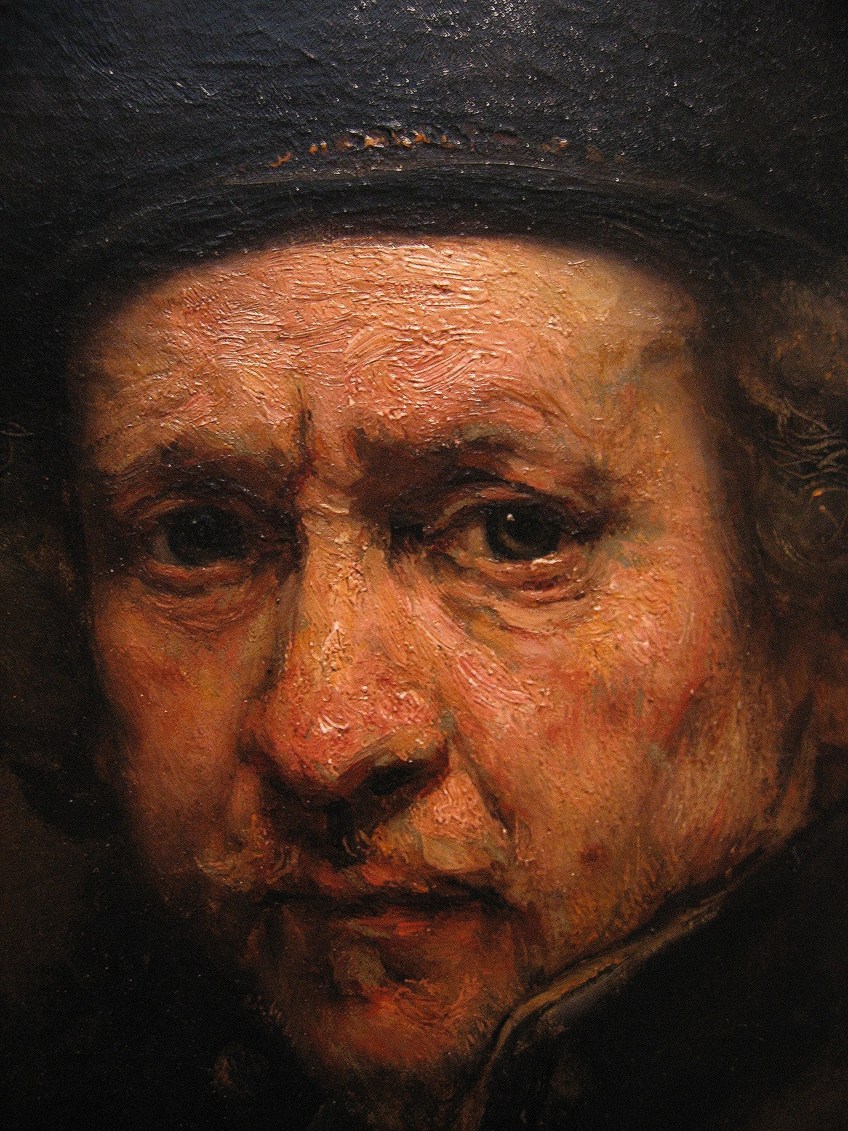
Despite the jagged liveliness of the artwork’s surface, there is no balance in the perception of ambient quality, as some passages are painted to seem clearer in focus, while some are less so; that’s often the outcome of fluctuation between areas of thickly impasted coats and those consisting of unclear brushstrokes. The paint’s relief generates light reflections that mimic the tactile feel of flesh.
Strokes of warm-toned thick paint pool up to simulate regions of light reflected on the brow, forehead, and cheek. Overlaps of gray-green underpainting around the temples, around the grooves of the right eye, and the nose flap are adjacent to these regions. A series of translucent glazes are applied to the right eyeball, followed by a small drop of white lead pigments for the highlights.
The brow is produced by an uneven succession of strokes; the fold above the upper lid is represented by a single stroke; the flesh above the face is sculpted with a round brush, and the wrinkles at the inner corner are indicated by a stroke of wet paint pushed over a dried underpainting. A harsh item, most likely a paintbrush handle, was used to highlight a wrinkle below the eye as well as to scrape into the wet paint of the hairs, generating sharp curls on which the larger stretches of hair recede.
Some of Rembrandt’s colleagues regarded the technique of surface variability as a form of illusionism or perceptibility.
Nonetheless, the drastic contrasts in paint application between the face and stretches of drapery and backdrop are remarkable for a late self-portrait. The overall impression is of a finished work, one that portrays the subject as marred by experience but ultimately steadfast in dignity.
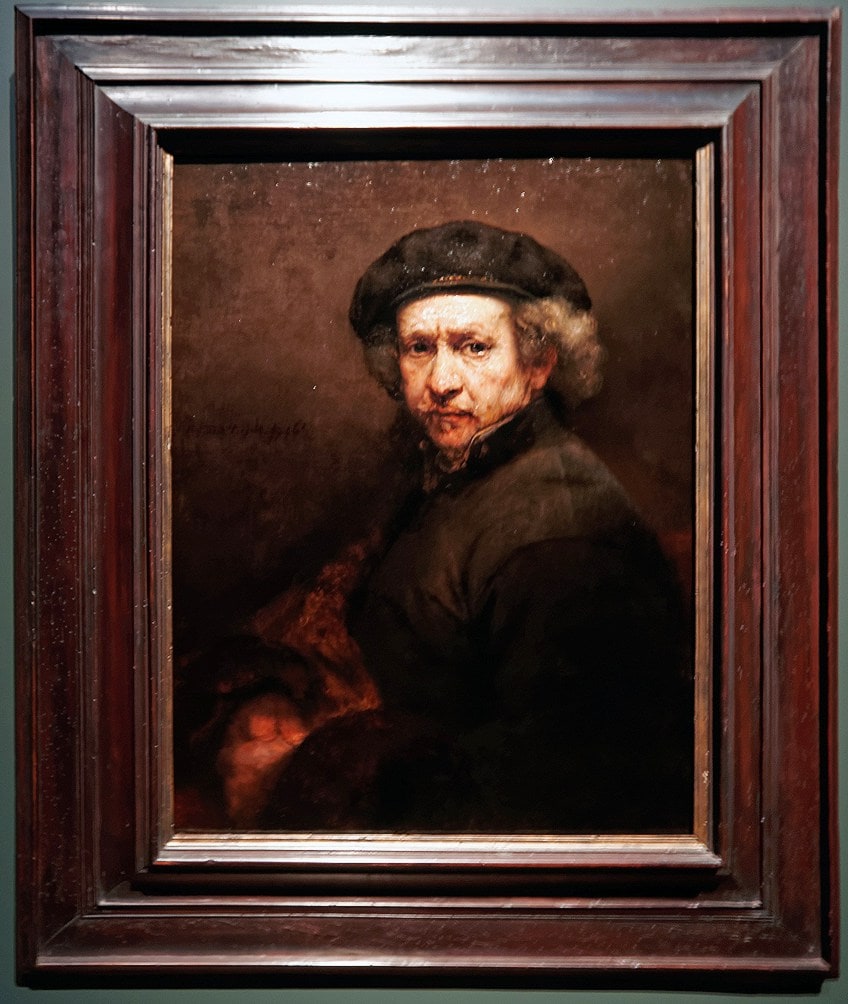
Condition and Provenance
The original support is a fine thread canvas that has been lined, with white lead put to the back of the lining. The picture is divided between two grounds, one deep red-brown, and one thin gray. The figure was originally created using brown under-paint that was left visible in numerous spots and has since been abraded.
The hands and face are in fair condition; substantial devastation in the figure and backdrop has been concealed with black overpainting, part of which was erased during a 1992 restoration. The artwork has been known to exist since 1767 when it was held by the 4th Earl of Cardigan and handed down to his child, Lady Elizabeth. It was possessed by John Charles, until 1929, when it was acquired by Andrew W. Mellon, who eventually gave it to the A.W. Mellon Educational and Charitable Trust.
And that concludes our look at a few examples of Rembrandt’s self-portraits. Rembrandt’s self-portraits include about 40 paintings, 31 etchings, and perhaps seven drawings. This was a substantial sum for any artist at the time, accounting for around 10% of his work in both paintings and engravings. Rubens, for example, despite his prolific productivity, only created seven self-portraits.
Frequently Asked Questions
Why Did Rembrandt Make So Many Self-Portraits?
The etchings are mostly casual, usually funny studies of exaggerated facial motions or portraiture in what amounted to fancy dress; the garments in some of them date back a century or more. In many others, he is making fun of himself. His oil paintings show his progression from an uncertain youthful man to the graceful and highly successful painter of the 1630s to the somber yet incredibly interesting images of his old age. They depict a marvelously accurate depiction of the guy, his looks, and his character, as seen through his beautifully worn face.
What Is the Rembrandt Museum?
The Rembrandt Museum is an art museum and historically important residence located in Amsterdam, Netherlands. Between 1639 and 1656, Rembrandt resided and worked at the home. The inside of the 17th century has been restored. The collection includes paintings by Rembrandt as well as paintings by his contemporaries. In 2014, the museum had 237,383 visitors. The home is located in Amsterdam’s Jodenbreestraat, not far from the city hall, where Rembrandt resided and painted for many years. The artist bought the property in 1639 and lived and worked there until 1656 when he declared bankruptcy and all of his belongings were put up for sale. The auction list made it possible to reassemble all of his items, which are now on display at the house. Following that, none of his belongings were found in the residence.
Who Was Rembrandt?
Rembrandt’s life and art were fueled by an in-depth psychological analysis of people, objects, and their environment, as well as genuine religious commitment. He was a phenomenal artist from a young age, becoming a master of portraiture, historical, religious, and mythological situations, as well as simple, attractive yet dramatic panoramas. He constructed his message with great sensitivity and immediacy, employing a range of materials and methodologies. His approaches to form, color, and shadows were always altering, culminating in the most highly moving but most natural parts of human existence. His incredible use of lighting and texture to portray emotional range goes through all of his works, firmly establishing him as one of art’s best and most imaginative artists.
Isabella studied at the University of Cape Town in South Africa and graduated with a Bachelor of Arts majoring in English Literature & Language and Psychology. Throughout her undergraduate years, she took Art History as an additional subject and absolutely loved it. Building on from her art history knowledge that began in high school, art has always been a particular area of fascination for her. From learning about artworks previously unknown to her, or sharpening her existing understanding of specific works, the ability to continue learning within this interesting sphere excites her greatly.
Her focal points of interest in art history encompass profiling specific artists and art movements, as it is these areas where she is able to really dig deep into the rich narrative of the art world. Additionally, she particularly enjoys exploring the different artistic styles of the 20th century, as well as the important impact that female artists have had on the development of art history.
Learn more about Isabella Meyer and the Art in Context Team.
Cite this Article
Isabella, Meyer, “Rembrandt Self-Portrait – Van Rijn’s Visual Autobiographies.” Art in Context. January 12, 2022. URL: https://artincontext.org/rembrandt-self-portrait/
Meyer, I. (2022, 12 January). Rembrandt Self-Portrait – Van Rijn’s Visual Autobiographies. Art in Context. https://artincontext.org/rembrandt-self-portrait/
Meyer, Isabella. “Rembrandt Self-Portrait – Van Rijn’s Visual Autobiographies.” Art in Context, January 12, 2022. https://artincontext.org/rembrandt-self-portrait/.


